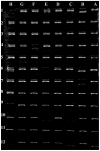Distinct HLA class I and II genotypes and haplotypes are associated with multiple sclerosis in Bahrain
- PMID: 30546882
- PMCID: PMC6256251
- DOI: 10.3892/br.2018.1164
Distinct HLA class I and II genotypes and haplotypes are associated with multiple sclerosis in Bahrain
Abstract
Multiple sclerosis (MS) has become prevalent in the Arabian Gulf area with high incidence in Bahrain due to environmental influences and genetic susceptibilities, but there is a lack of study into human leukocyte antigen (HLA) types in patients with MS in Bahrain. The present study aimed to study the HLA types expressed in MS patients compared with in control subjects. Blood samples from 50 Bahraini patients with MS and 50 Bahraini control subjects' were subjected to HLA tissue typing by polymerase chain reaction using sequence-specific primers. In comparison with those in control subjects, the allele frequencies of HLA class-I antigens A2, A9, A19, B5, B35 and B40 were higher in MS patients. For class II antigens, the allele frequencies of DR3, DR4 and DR16 were higher in MS patients. The allele frequency of DR15 was lower in MS patients than in control subjects but the difference was not statistically significant (P=0.138). The higher prevalence of the HLA-ABDR allele was common among the female patients with MS, in relapse remission stage, in cases with higher expanded disability status scale scores and with disease duration between 4 and 9 years. Haplotype HLA-A2-B40-DR2 exhibited significantly higher frequency in MS patients compared with in control subjects (P=0.03). In conclusion, the results indicated different alleles associated with MS compared with previous reviews. The present study supports the importance of identifying genetic susceptibilities and targets for therapies in specific populations and individuals, to personalize disease management in terms of prediction, protective measures and treatment.
Keywords: alleles; expanded disability status scale; genes; human leukocyte antigen typing; multiple sclerosis; polymerase chain reaction.
Figures



Similar articles
-
HLA determinants of susceptibility to multiple sclerosis in an Arabian Gulf population.Mult Scler. 2004 Aug;10(4):381-6. doi: 10.1191/1352458504ms1065oa. Mult Scler. 2004. PMID: 15327033
-
Contribution of selective HLA-DRB1/DQB1 alleles and haplotypes to the genetic susceptibility of type 1 diabetes among Lebanese and Bahraini Arabs.J Clin Endocrinol Metab. 2005 Sep;90(9):5104-9. doi: 10.1210/jc.2005-1166. Epub 2005 Jun 28. J Clin Endocrinol Metab. 2005. PMID: 15985473
-
HLA antigen distribution in Jain population from Mumbai, Maharashtra, India.Indian J Med Res. 2001 Jul;114:25-9. Indian J Med Res. 2001. PMID: 11762203
-
HLA-DR15 haplotype and multiple sclerosis: a HuGE review.Am J Epidemiol. 2007 May 15;165(10):1097-109. doi: 10.1093/aje/kwk118. Epub 2007 Feb 28. Am J Epidemiol. 2007. PMID: 17329717 Review.
-
Human leukocyte antigen studies in multiple sclerosis.Ann Neurol. 1994;36 Suppl:S15-7. doi: 10.1002/ana.410360706. Ann Neurol. 1994. PMID: 8017880 Review.
Cited by
-
Association of infections with multiple sclerosis in Gulf Cooperation Council countries: a review.J Int Med Res. 2020 Apr;48(4):300060519884151. doi: 10.1177/0300060519884151. Epub 2019 Dec 27. J Int Med Res. 2020. PMID: 31880177 Free PMC article. Review.
-
A review of possible therapies for multiple sclerosis.Mol Cell Biochem. 2021 Sep;476(9):3261-3270. doi: 10.1007/s11010-021-04119-z. Epub 2021 Apr 22. Mol Cell Biochem. 2021. PMID: 33886059 Review.
-
Myelin Basic Protein Fragmentation by Engineered Human Proteasomes with Different Catalytic Phenotypes Revealed Direct Peptide Ligands of MS-Associated and Protective HLA Class I Molecules.Int J Mol Sci. 2023 Jan 20;24(3):2091. doi: 10.3390/ijms24032091. Int J Mol Sci. 2023. PMID: 36768413 Free PMC article.
-
Major histocompatibility complex (MHC) associations with diseases in ethnic groups of the Arabian Peninsula.Immunogenetics. 2021 Apr;73(2):131-152. doi: 10.1007/s00251-021-01204-x. Epub 2021 Feb 2. Immunogenetics. 2021. PMID: 33528690 Free PMC article. Review.
-
HLA-class II genes association with multiple sclerosis: An immunogenetic prediction among multiple sclerosis Jordanian patients.PLoS One. 2025 Feb 25;20(2):e0318824. doi: 10.1371/journal.pone.0318824. eCollection 2025. PLoS One. 2025. PMID: 39999097 Free PMC article.
References
LinkOut - more resources
Full Text Sources
Research Materials
